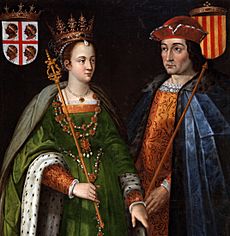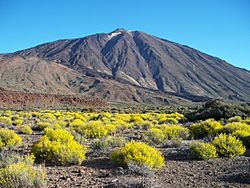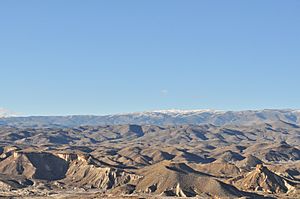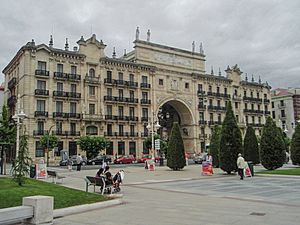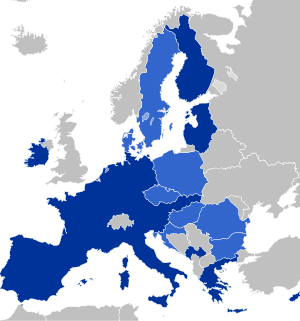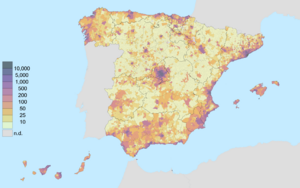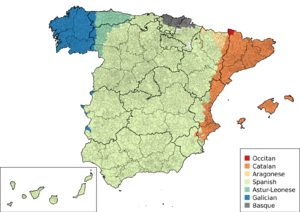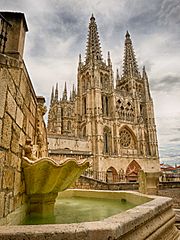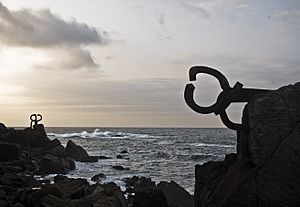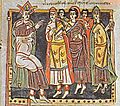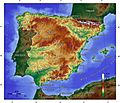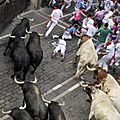Spain facts for kids
Quick facts for kids
Kingdom of Spain
|
|
|---|---|
|
Location of Spain (dark green)
– on the European continent (green & dark grey) |
|
| Capital and largest city
|
Madrid 40°26′N 3°42′W / 40.433°N 3.700°W |
| Official language | Spanish |
| Nationality (2024) |
|
| Religion
(2023)
|
|
| Demonym(s) |
|
| Government | Unitary parliamentary constitutional monarchy |
|
• Monarch
|
Felipe VI |
| Pedro Sánchez | |
| Francina Armengol | |
| Legislature | Cortes Generales |
| Senate | |
| Congress of Deputies | |
| Formation | |
| 20 January 1479 | |
| 14 March 1516 | |
| 9 June 1715 | |
| 19 March 1812 | |
| 29 December 1978 | |
| Area | |
|
• Total
|
505,990 km2 (195,360 sq mi) (51st) |
|
• Water (%)
|
0.89 |
| Population | |
|
• 2024 estimate
|
|
|
• Density
|
96/km2 (248.6/sq mi) (121th) |
| GDP (PPP) | 2024 estimate |
|
• Total
|
|
|
• Per capita
|
|
| GDP (nominal) | 2024 estimate |
|
• Total
|
|
|
• Per capita
|
|
| Gini (2023) | ▼ 31.5 medium |
| HDI (2022) | very high · 27th |
| Currency | Euro (€) (EUR) |
| Time zone | UTC±0 to +1 (WET and CET) |
|
• Summer (DST)
|
UTC+1 to +2 (WEST and CEST) |
| Note: most of Spain observes CET/CEST, except the Canary Islands which observe WET/WEST. | |
| Calling code | +34 |
| ISO 3166 code | ES |
| Internet TLD | .es |
Spain is a country in Southern Europe. It is located on the Iberian Peninsula, sharing borders with Portugal and Gibraltar. To its northeast, Spain borders France and Andorra, where the Pyrenees mountains are found.
People from Spain are called Spaniards. Most people speak Spanish, also known as "Castellano." However, other languages are spoken in different parts of the country. These include Catalan, Basque, Galician, Leonese, Aragonese, Aranese Occitan, and even Portuguese. The main religion in Spain is Roman Catholicism.
Since 1975, Spain has been a constitutional monarchy. This means it has a king, Felipe VI, but his power is limited by a constitution. The king can declare war only if the government asks him to. The country's parliament is called Las Cortes Generales. It has two parts: "El Congreso" (The Congress) and "El Senado" (The Senate). People choose their representatives in parliament by voting. The current Prime Minister is Pedro Sánchez.
The main government buildings and the king's palace are in Madrid. Madrid is also the capital city of Spain.
Spain covers more than 500,000 square kilometres of land. It is smaller than France but larger than Sweden or Germany. Nearly 50 million people live in Spain.
Spain is divided into 17 parts called autonomous communities. Each of these parts has its own local government. This allows them to make some decisions for themselves.
Contents
Exploring Spain's Past
Ancient Times in Spain
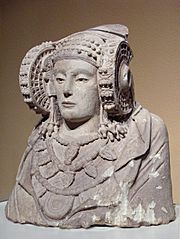
People have lived in Spain for a very long time, since the Stone Age. Some of the first groups were the Iberians and Celts. The Phoenicians also built cities there to trade for tin and silver. Later, the Roman Empire ruled Spain for about 500 years. When the Roman Empire weakened, Germanic groups like the Visigoths moved in and took control.
Muslim Rule in Spain
In 711 AD, groups from North Africa called the Moors took over most of Spain. They ruled for 800 years and called the land Al-Andalus. The Moors were Muslims, and their civilization was very advanced. They were rich from controlling the gold trade from West Africa. They built many beautiful buildings, especially in cities like Seville, Granada, and Cordoba. Many of these buildings can still be seen today.
Muslim Spain was a place where different cultures lived together. Jews, Christians, and Muslims lived side by side. Learning was very important in Muslim Spain. It had one of the largest library systems outside of Baghdad.
The Rise of Christian Kingdoms
The Kingdom of León was very important in early Spanish history. In 1188, it created the first democratic parliament in Europe, called Cortes de Llión. This parliament included representatives from ordinary people. León remained an independent territory until 1833.
Christian kingdoms gradually grew stronger in Spain. Two important kingdoms, Castile and Aragon, united in 1469. This happened when King Ferdinand II of Aragon married Queen Isabella of Castile. They ruled all of Spain together.
In 1492, a very important year, Ferdinand and Isabella sent Christopher Columbus to sail across the Atlantic Ocean. Columbus discovered islands in the Caribbean Sea. Later, other explorers like Hernán Cortés and Francisco Pizarro found the continents of North America and South America. Spain then built a large empire by taking control of vast areas in these continents.
However, this empire did not make Spain rich because much of the money was spent on wars. Many wars were fought against other European countries trying to take over parts of the Americas. During this time, Muslim writings were destroyed or taken away. Jews were also forced to leave Spain or become Christians. But some parts of Muslim culture, like music and stringed instruments, were kept. Many Arab words also became part of the Spanish language.
Spain in the 16th and 17th Centuries
Charles, the grandson of Ferdinand and Isabella, became king. He inherited Castile, Aragon, and many other territories from his grandfathers. He was known as Charles I in Spain and also as Emperor Charles V of the Holy Roman Empire. This made the Spanish empire larger than ever. However, it was a collection of independent countries under one king, not a single unified nation. Charles also fought against the Protestant Reformation in Europe.
Spain in the 18th Century
During the 18th century, some parts of Spain's large empire became independent countries. Others were taken over by new nations, like the United States of America.
Spain in the 19th Century
In the 19th century, Napoleon of France invaded Spain and other European countries. Spain, Britain, and other European nations sent troops to defend the Iberian Peninsula.
Spain in the 20th Century
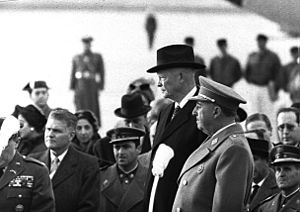
The early 20th century was a time of trouble in Spain. Some Spaniards tried to create a democracy, and King Alfonso XIII had to leave the country. But in 1936, two groups of Spaniards fought in the Spanish Civil War. One group wanted democracy, while the other wanted a single leader. In 1939, the democratic side was defeated. A nationalist dictator named Francisco Franco took control of the government.
Francisco Franco died in 1975. He had planned for Spain to become a monarchy again. He chose Juan Carlos, the grandson of a former king, to be the new king. He also chose Adolfo Suárez to be the first Prime Minister. But King Juan Carlos and Suárez decided to set up a democracy instead of a dictatorship.
In 1981, some people who supported the old dictator tried to take over the Spanish Parliament by force. They fired guns in the air, and it was shown live on television. Many people feared another civil war. However, King Juan Carlos I quickly spoke on television, telling everyone to stay calm. The people who tried to take over were arrested.
Today, Spain is a modern democratic country. It trades with many nations around the world. It is the 15th largest economy globally and an important member of the European Union.
Spain in the 21st Century
On June 2, 2014, King Juan Carlos I announced he would step down. His son, Felipe VI, became the new king on June 19, 2014.
Religion in Spain
In ancient times, most religions in Spain were pagan. Today, about 56% of Spain's population is Roman Catholic. Many famous Catholic figures, like Teresa of Ávila, came from Spain. Other Christian groups, like Orthodox Christians, are also present.
Other religions in Spain include Muslim, Baha'i, Buddhist, Jain, and Zoroastrianism. Spain also has many people who are atheist (do not believe in God) or agnostic (are unsure about God).
Geography of Spain
The center of Spain is a high, dry, flat area called La Meseta. Summers there are very hot, and winters can be cold. Spain also has many mountain ranges. Mount Teide in the Canary Islands is the highest mountain in Spain. It is also the third largest volcano in the world from its base.
In the north, there are mountains called Los Picos de Europa (The European Peaks). Winters here are cold with lots of snow, but summers are mild and warm.
In the southeast, you'll find the La Sierra Nevada (The Snowy Mountains). This range has Mulacen, the highest mountain in mainland Spain, at 2,952 meters. La Sierra Nevada is popular for winter sports, especially skiing. Snow stays on its peaks all year. The south coast of Spain has a warm and temperate climate, meaning it's not too hot or too cold. Because Spain is in southern Europe, it gets a lot of sunshine. Many people from Northern Europe visit Spain for its beaches and cities.
Spain shares a border with Portugal to the west. To the north, it borders France and Andorra. In the south, Spain borders Gibraltar, which is a British territory. Spain also has two cities, Ceuta and Melilla, located in North Africa, bordering Morocco.
Spain's Regions
Spain is divided into 17 Autonomous Communities. These communities have their own regional governments. Here are some of them and their capital cities:
- Andalucía (capital: Seville)
- Aragon (capital: Zaragoza)
- Asturias (capital: Oviedo)
- Balearic Islands (capital: Palma de Mallorca)
- Basque Country (capital: Vitoria)
- Canary Islands (capitals: Santa Cruz de Tenerife and Las Palmas)
- Catalonia (capital: Barcelona)
- Madrid Community (capital: Madrid)
- Valencia Community (capital: Valencia)
Major Cities in Spain
Many people in Spain live in or near cities. Here are the ten largest city areas:
| Pos. | City area | Region | Prov. | population (city + area) |
|---|---|---|---|---|
| 1 | Madrid | Madrid | Madrid | 5,263,000 |
| 2 | Barcelona | Catalonia | Barcelona | 4,251,000 |
| 3 | Valencia | Valencian Community | Valencia | 1,499,000 |
| 4 | Sevilla | Andalucia | Seville | 1,262,000 |
| 5 | Bilbao | Basque Country | Biscay | 947,000 |
| 6 | Málaga | Andalusia | Málaga | 844,000 |
| 7 | Oviedo–Gijón | Asturias | Asturias | 844,000 |
| 8 | Alicante–Elche | Valencian Community | Alicante | 793,000 |
| 9 | Las Palmas de Gran Canaria | Canarias | Las Palmas de Gran Canaria | 640,000 |
| 10 | Zaragoza | Aragon | Zaragoza | 639,000 |
Spain's Climate

Spain has three main climate zones based on its geography and mountains:
- The Mediterranean climate is found in most of the country. It has warm or hot, dry summers. This climate is common along the Mediterranean and Southern Atlantic coasts. It is also found inland in Andalusia and Extremadura.
- The semi-arid climate is common in the southeastern part of Spain. It is also found in other areas like the Region of Murcia and parts of Valencia and eastern Andalusia. This climate means the dry season lasts longer than just summer.
- The oceanic climate is in the northern part of Spain. This includes regions like the Basque Country, Cantabria, and Asturias. In these areas, ocean winds keep winter and summer temperatures mild. There is also no dry season.
Animals and Plants of Spain
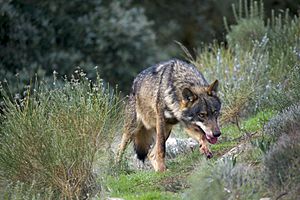
Spain has a wide variety of animals (fauna). This is because of its location between the Atlantic Ocean and the Mediterranean Sea. It is also between Africa and Eurasia. Spain's diverse climates and regions create many different habitats for animals.
The plants (vegetation) in Spain are also very diverse. This is due to its varied landscape, climate, and latitude. Spain has different plant regions. Each region has its own types of plants. These plants are shaped by the climate, land features, soil, and even fires.
How Spain is Governed
The Spanish Constitution sets up how the government works. It divides power among five main parts. The most important symbol of the Spanish state is the Crown, which represents the country's history and future. Spain is a "parliamentary monarchy." This means the king or queen is the head of state. The monarch helps solve disagreements between different parts of the government. They also help prevent anyone from using too much power.
The monarch helps keep the country united. They represent Spain to other countries, especially those with historical ties to Spain. The king or queen also makes sure the government runs smoothly. They protect representative democracy and the rule of law. In short, the Crown protects the Spanish constitution and the rights of all Spaniards.
The monarch has many duties and powers. Most of these are ceremonial. This means the monarch performs them as a formal duty, usually following the advice of the prime minister. For example, the monarch signs laws passed by the parliament. They also appoint ministers and judges based on advice from others. The monarch is also the supreme commander of the Armed Forces. They declare war and make peace, but only with the prime minister's advice and parliament's approval.
However, the monarch also has some special powers. They can use these powers when needed to keep the government stable. For instance, the monarch can be kept informed about state matters. They can also dissolve the parliament and call for new elections if the prime minister asks. The monarch can also order national referendums (public votes) if the prime minister requests it and parliament agrees.
The monarch also plays a role in the justice system. They appoint members of the General Council of the Judiciary. They also appoint judges to the Constitutional Tribunal.
One of the most important powers of the monarch is choosing a candidate for prime minister. The monarch appoints the prime minister based on whether they can get enough support from the parliament. If parliament cannot agree on a new government, the monarch can dissolve it and call for new elections. The monarch makes these decisions after talking with the president of the Congress of Deputies.
The Spanish Parliament

The power to make laws belongs to the Cortes Generales. This is Spain's parliament, and it is chosen by the people. It has two parts:
- The Congress of Deputies (Congreso de los Diputados) is the lower house. It has 350 members called deputies. People vote for these deputies in elections every four years.
- The Senate (Senado) is the upper house. It has 259 senators. Most senators are directly elected by the people. The rest are chosen by regional parliaments. Senators also serve four-year terms.
The Spanish Government
The power to run the country belongs to the Government. This group is responsible to the Congress of Deputies. It includes the prime minister, one or more deputy prime ministers, and various ministers. Together, they form the Council of Ministers. This Council manages the government's work and the country's public services. The Government stays in power as long as it has the support of the Congress of Deputies.
The prime minister is the head of government. They have the main power to lead and coordinate the government's policies. The Spanish monarch chooses the prime minister after talking with different political groups. The prime minister is then officially appointed after a vote of confidence in the Congress of Deputies.
Spain's Economy
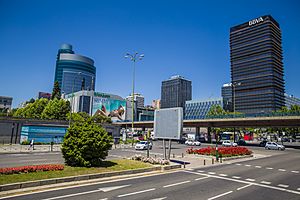
Since the 1990s, some Spanish companies have become very big and operate worldwide. They often expand into Latin America because of shared culture. Spain is the second-largest foreign investor there, after the United States. Spanish companies have also grown in Asia, especially in China and India. This early global expansion gives them an advantage over other European companies. This is partly because of the growing interest in Spanish language and culture in Asia and Africa. Also, Spanish companies are used to taking risks in new markets.
Spanish companies have invested in many areas. These include renewable energy (like Iberdrola, a big renewable energy operator). They also include technology companies like Telefónica and Abengoa. Other important companies are Mondragon Corporation (a large worker-owned cooperative) and Movistar. Spain also has major construction firms like Ferrovial and Acciona.
Car Manufacturing
The car manufacturing industry is a big employer in Spain. In 2015, Spain was the 8th largest car producer in the world. It was the 2nd largest in Europe, after Germany.
By 2016, the car industry made up 8.7% of Spain's total economy. It employed about 9% of all manufacturing workers. In 2015, about 80% of all cars made in Spain were sent to other countries.
German companies invested a lot of money in Spain's car industry in 2015. This shows how important Spain is for car production in Europe.
Farming in Spain
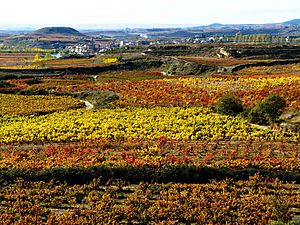
Farming in Spain happens in two main ways. About 85% of farmland relies only on rainfall for water. This is called secano (non-irrigated cultivation). It includes humid areas in the north and dry areas that are not irrigated. The other way is regadío (irrigated cultivation), which is much more productive. In 1986, about 3 million hectares (about 7.4 million acres) were irrigated. The government hoped to double this area. A good example is Almería, a very dry province. Here, farmers grow fruits and vegetables in winter to export to Europe.
More than half of the irrigated land is used for corn, fruit trees, and vegetables. Other crops that benefit from irrigation include grapes, cotton, sugar beets, potatoes, legumes, olive trees, and strawberries. In some areas, farmers can grow two crops in the same year.
Traditional Spanish farm products are still important. These include citrus fruits, vegetables, cereal grains, olive oil, and wine. Spain's warm climate and closeness to European markets make citrus fruits its top agricultural export. Fresh vegetables and fruits grown with irrigation are also important exports. Sunflower seed oil is also produced to compete with more expensive olive oils.
Tourism in Spain
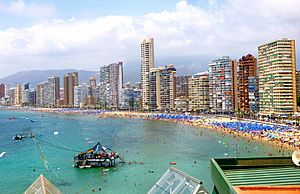
In 2017, Spain was the second most visited country in the world. It welcomed 82 million tourists. This was the fifth year in a row that tourist numbers broke records. The main office of the World Tourism Organization is in Madrid.
Spain's location, popular coastlines, varied landscapes, rich history, lively culture, and good infrastructure make it a top tourist destination. Over the last 50 years, international tourism in Spain has grown a lot. It is now the second largest in the world in terms of money spent by tourists. In 2006, tourism brought in about 40 billion Euros, which was about 5% of Spain's economy.
Castile and Leon is a leader in rural tourism. People visit to enjoy its natural beauty and old buildings.
People of Spain
In 2024, Spain had about 48.9 million people. Most of the population, 86.5%, are native Spaniards. The remaining 13.5% are people from other countries. These immigrants mainly come from Latin America (39%), North Africa (16%), and Eastern Europe (15%).
Spain also has people whose families came from former colonies, especially in Latin America and North Africa. Smaller groups of immigrants come from countries in Sub-Saharan Africa and Asia. The largest group of immigrants are from other European countries, like Romanians, Britons, and Germans.
Languages Spoken in Spain
Spain is a country where many languages are spoken. Spanish, also called castellano (Castilian), has been the official language of the whole country since 1931. The Spanish Constitution allows other "Spanish languages" to also be official in their own regions.
About 74% of Spaniards speak Spanish as their first language. Catalan or Valencian is spoken by 17%, Galician by 7%, and Basque by 2%.
Some of the most common foreign languages spoken by immigrant communities include Moroccan Arabic, Romanian, and English.
Spanish Culture
Spain is a Western country. Its culture is deeply influenced by its Roman past. This makes Spain one of the main Latin countries in Europe. Spanish culture also has strong ties to Catholicism. This religion played a key role in shaping the country. Spanish art, architecture, food, and music have been influenced by many different groups over time. The country's Mediterranean climate and geography also played a part. For centuries, Spain had a large empire. This helped spread Spanish language and culture around the world. Spain also took in cultural ideas from its diverse empire.
World Heritage Sites in Spain
Spain has 47 World Heritage Sites. These are special places recognized by UNESCO. Some are shared with other countries. For example, the landscape of Monte Perdido in the Pyrenees is shared with France. The Prehistoric Rock Art Sites of the Côa Valley and Siega Verde are shared with Portugal. Spain also has 14 "Human treasures," which are examples of Intangible cultural heritage.
Spanish Art
Spanish artists have greatly influenced European and American artistic movements. Spanish art has many influences due to its history, geography, and different time periods. The Mediterranean heritage, with Roman and Moorish influences, is still visible today. European influences came from Italy, Germany, and France. This was especially true during the Renaissance and Spanish Baroque periods. Spain also has its own unique art styles.
During the Golden Age of Spain, famous painters included El Greco and Diego Velázquez. Velázquez created well-known Spanish portraits like Las Meninas. Francisco de Goya painted during a time of great change in Spain. He showed the wars and political struggles of his era.
Later, important modern artists emerged. These include impressionist painter Joaquín Sorolla. Famous modernism artists like Pablo Picasso, Salvador Dalí, and Joan Miró also came from Spain.
Spanish Sculpture
The Plateresque style was popular in the 16th century. It influenced many great Spanish artists. Alonso Berruguete is known as the "Prince of Spanish sculpture." His works include carvings in the Cathedral of Toledo. Other notable sculptors were Juan de Juni and Damià Forment.
Two important sculpture schools developed in Andalusia. The Seville School included Juan Martínez Montañés. The Granada School included Alonso Cano. In the 20th century, major Spanish sculptors were Julio González, Eduardo Chillida, and Pablo Serrano.
Spanish Architecture
Spanish architecture has many influences due to its diverse history and geography. Córdoba was an important Roman city. It later became a cultural capital under Islamic rule. During this time, beautiful Arabic-style architecture was built. This style continued to develop under later Islamic rulers. The Nasrid built the famous palace complex in Granada.
At the same time, Christian kingdoms developed their own styles. They created a pre-Romanesque style when they were isolated from other European influences. Later, they adopted Romanesque and Gothic styles. Many impressive Gothic buildings were constructed across Spain. The Mudéjar style combined Arab patterns and elements with European architecture.
In the 20th century, Modernism became popular. This led to many new architectural designs. A famous style in Barcelona, called modernisme, produced important architects like Gaudí. Today, Spain is known for its contemporary architecture. Spanish architects like Rafael Moneo and Santiago Calatrava are famous worldwide.
Music and Dance in Spain
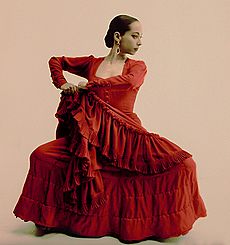
Many people outside Spain think of flamenco when they hear Spanish music. Flamenco is a musical style from West Andalusia. However, Spain has many other regional styles of folk music. These are found in Aragon, Catalonia, Valencia, and other regions. Pop, rock, hip hop, and heavy metal are also popular.
In classical music, Spain has produced famous composers like Isaac Albéniz and Manuel de Falla. Well-known singers include Plácido Domingo and Montserrat Caballé. Spain has over forty professional orchestras. Major opera houses include the Teatro Real in Madrid.
Many music fans visit Spain for summer music festivals. Sónar features pop and techno acts. Benicàssim often has alternative rock and dance music. These festivals show Spain's importance in the international music scene.
The guitar is the most popular traditional musical instrument and originated in Spain. In the north, traditional bagpipers, or gaiteros, are common, especially in Asturias and Galicia.
Spanish Food
Languages in Spain
While Spanish is the most spoken language in the country, other languages like Catalan, Basque or Galician are also spoken in a few territories.
Public Holidays and Festivals
Spain celebrates a mix of religious, national, and local holidays. Each town can choose up to 14 public holidays per year. The national government chooses up to nine of these, and local areas choose at least two. Spain's National Day is celebrated on October 12.
Spain has many famous festivals. One of the most well-known is San Fermín in Pamplona. Its most famous event is the encierro, or the running of the bulls. Over a million people attend this festival every year.
Other popular festivals include:
- La Tomatina tomato festival in Buñol, Valencia.
- The carnivals in the Canary Islands.
- The Falles in Valencia.
- Holy Week celebrations in Andalusia and Castile and León.
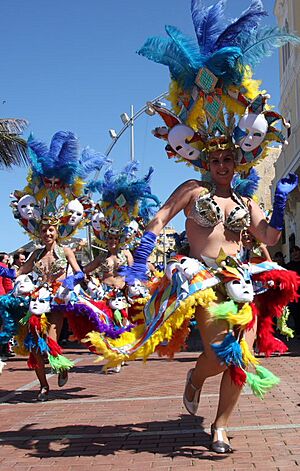
Other pages
Images for kids
-
The Lady of Elche, from the 4th century BCE.
-
The Roman Theatre in Mérida.
-
Reccared I and bishops during Council III of Toledo, 589.
-
Votive crown of Recceswinth from the Treasure of Guarrazar.
-
The interior of the Great Mosque of Córdoba.
-
In 1030, the Kingdom of Navarre controlled the Count of Aragon and the Count of Castile.
-
Hernán Cortés and La Malinche meeting Aztec emperor Moctezuma II in Tenochtitlan.
-
Puerta del Sol, Madrid, after the Spanish Revolution of 1868.
-
Demonstration in Barcelona during the 1909 Tragic Week.
-
Republican volunteers at Teruel, 1936.
-
Felipe González signing the treaty to join the European Economic Community in 1985.
-
The 1992 Summer Olympics in Barcelona.
-
Satellite image of Mallorca island.
-
Teide, an active volcano in Santa Cruz de Tenerife, Canary Islands.
-
Renault factory in Valladolid.
-
Olive orchards in Andalusia.
-
Benidorm, one of Europe's largest coastal tourist destinations.
-
Andasol was the first parabolic trough power plant in Europe.
-
GranTeCan reflecting telescope.
-
Population pyramid of Spain from 1950 to 2014.
-
The interior of the Hermitage of El Rocío during a Catholic ceremony.
-
Manuscript of the 13th-century Grande e general estoria.
-
Pedro Almodóvar and Penélope Cruz in Oviedo.
-
Flamenco is an Andalusian artistic form.
-
Spain or La Roja lineup in 2015.
-
Encierro, San Fermín, in Pamplona.
See also
 In Spanish: España para niños
In Spanish: España para niños






